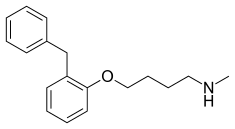Bifemelane
Bifemelane (INN) (Alnert, Celeport), or bifemelane hydrochloride (JAN), also known as 4-(O-benzylphenoxy)-N-methylbutylamine, is an antidepressant and cerebral activator that is widely used in the treatment of cerebral infarction patients with depressive symptoms in Japan, and in the treatment of senile dementia as well.[1][2] It also appears to be useful in the treatment of glaucoma.[3] Bifemelane acts as a monoamine oxidase inhibitor (MAOI) of both isoenzymes, with competitive (reversible) inhibition of MAO-A (Ki = 4.20 μM) (making it a reversible inhibitor of monoamine oxidase A (RIMA)) and non-competitive (irreversible) inhibition of MAO-B (Ki = 46.0 μM),[4][5][6] and also acts (weakly) as a norepinephrine reuptake inhibitor.[7] The drug has nootropic, neuroprotective, and antidepressant-like effects in animal models, and appears to enhance the cholinergic system in the brain.[8][9][10]
 | |
| Clinical data | |
|---|---|
| Trade names | Alnert, Celeport |
| Other names | MCl-2016 |
| AHFS/Drugs.com | International Drug Names |
| ATC code | |
| Identifiers | |
IUPAC name
| |
| CAS Number | |
| PubChem CID | |
| ChemSpider | |
| UNII | |
| ChEMBL | |
| CompTox Dashboard (EPA) | |
| ECHA InfoCard | 100.220.566 |
| Chemical and physical data | |
| Formula | C18H23NO |
| Molar mass | 269.381 g/mol g·mol−1 |
| 3D model (JSmol) | |
SMILES
| |
InChI
| |
| | |
See also
References
- Koide S, Onishi H, Hashimoto H, Kai T, Katayama M, Yamagami S (1995). "Effects of bifemelane hydrochloride on plasma neuropeptide Y, 3-methoxy-4-hydroxyphenylethylene glycol and 5-hydroxy-indole acetic acid concentrations in patients with cerebral infarction". Drugs Exp Clin Res. 21 (5): 175–80. PMID 8846747.
- David J. Triggle (1996). Dictionary of Pharmacological Agents. Boca Raton: Chapman & Hall/CRC. p. 265. ISBN 978-0-412-46630-4.
- Shigemitsu, T; Majima, Y (1996). "Use of bifemelane hydrochloride in improving and maintaining the visual field of patients with glaucoma". Clinical Therapeutics. 18 (1): 106–13. doi:10.1016/S0149-2918(96)80183-4. PMID 8851457.
- Naoi, Makoto; Nomura, Yoshio; Ishiki, Ryoji; Suzuki, Hiroko; Nagatsu, Toshiharu (1988). "4-(O-Benzylphenoxy)-N-Methylbutylamine (Bifemelane) and Other 4-(O-Benzylphenoxy)-N-Methylalkylamines as New Inhibitors of Type A and B Monoamine Oxidase". Journal of Neurochemistry. 50 (1): 243–247. doi:10.1111/j.1471-4159.1988.tb13256.x. ISSN 0022-3042. PMID 3335842.
- Kovel'man, I. R.; Tochilkin, A. I.; Gorkin, V. Z. (1991). "Structure and action of reversible monoamine oxidase inhibitors (review)". Pharmaceutical Chemistry Journal. 25 (8): 505–520. doi:10.1007/BF00777412. ISSN 0091-150X.
- Jae Y. Choe (4 March 2011). Drug Actions and Interactions. McGraw Hill Professional. p. 307. ISBN 978-0-07-176945-7.
- Dostert, P. (1994). "Can our knowledge of monoamine oxidase (MAO) help in the design of better MAO inhibitors?". Amine Oxidases: Function and Dysfunction. pp. 269–279. doi:10.1007/978-3-7091-9324-2_35. ISBN 978-3-211-82521-1.
For example, bifemelane [4-(O-benzylphenoxy)-N-methylbutylamine) is one of the few molecules in which both activities, reversible inhibition of MAO-A (Naoi et al., 1988) and inhibition of noradrenaline uptake (Egawa et al., 1983), although weak (IC50 = 10-6-10-7 M), coexist.
- Kondo, Y; Ogawa, N; Asanuma, M; Matsuura, K; Nishibayashi, K; Iwata, E (1996). "Preventive effects of bifemelane hydrochloride on decreased levels of muscarinic acetylcholine receptor and its mRNA in a rat model of chronic cerebral hypoperfusion". Neuroscience Research. 24 (4): 409–14. doi:10.1016/0168-0102(95)01017-3. PMID 8861111.
- Egashira, T; Takayama, F; Yamanaka, Y (1996). "Effects of bifemelane on muscarinic receptors and choline acetyltransferase in the brains of aged rats following chronic cerebral hypoperfusion induced by permanent occlusion of bilateral carotid arteries". Japanese Journal of Pharmacology. 72 (1): 57–65. doi:10.1254/jjp.72.57. PMID 8902600.
- Moryl E, Danysz W, Quack G (June 1993). "Potential antidepressive properties of amantadine, memantine and bifemelane". Pharmacology & Toxicology. 72 (6): 394–7. doi:10.1111/j.1600-0773.1993.tb01351.x. PMID 8361950.